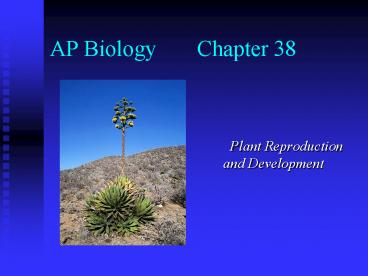AP Biology Chapter 38 - PowerPoint PPT Presentation
Title:
AP Biology Chapter 38
Description:
AP Biology Chapter 38 Plant Reproduction and Development Sexual Reproduction Alternation of generations: haploid (n) and diploid (2n) generations take turns producing ... – PowerPoint PPT presentation
Number of Views:59
Avg rating:3.0/5.0
Title: AP Biology Chapter 38
1
AP Biology Chapter 38
- Plant Reproduction and Development
2
Sexual Reproduction
- Alternation of generations haploid (n) and
diploid (2n) generations take turns producing
each other - Sporophyte (2n) produces haploid spores by
meiosis these spores divide by mitosis giving
rise to male and female haploid plants called. - Gametophytes (n) develop and produce gametes
3
Floral variations
- Floral organs sepals, petals, stamens (male ),
carpels (female) - complete all 4 floral organs
- incomplete lacking 1 or more floral organs
- perfect both stamens and carpels on 1 flower
- imperfect lacking either a stamen or carpel
- monoecious staminate and carpellate flowers on
1 plant) - dioecious staminate and carpellate flowers on
separate plants
4
Gametophyte development
- Male gametophyte microsporocyte (in pollen sacs
of anther) divides by meiosis into 4-1N
microspores mitosis produces a generative cell
(sperm) and a tube cell (pollen tube) a pollen
grain - Female gametophyte megasporocyte (in
ovule) divides by meiosis to 4 cells, only 1
survives to a 1-N megaspore 3 mitotic divisions
forms the embryo sac includes 1 egg cell
(female gamete) and 2 polar nuclei (synergids)
5
Double fertilization
- Pollination (pollen grain lands on a receptive
stigma) - Tube cell (pollen tube produced down the style)
- Generative cell (2 sperm by mitosis)
- Enters ovary through micropyle
- 1 sperm fertilizes egg to form zygote other
sperm combines with 2 polar nuclei to form 3n
endosperm (food-storing tissue)
6
Plant fertilization
7
The seed
- From fertilized ovule..
- The mature seed
- seed coat (protection)
- cotyledons (seed leaves)
- hypocotyl (lower embryonic axis)
- radicle (embryonic root)
- epicotyl (upper embryonic axis)
- plummule (shoot tip)
- coleoptile (sheath for embryonic shoot)
8
Seed development
9
The fruit
- From ovary.
- Fruit protects seeds and aids in their dispersal
- Pericarp (thickened wall of fruit from ovary
wall) - Fruit types
- simple (1 ovary/1 flower) cherry, soybean
- aggregate (1 flower with many carpels/ovaries)
blackberry - multiple (inflorescence group of
flowers/ovaries) pineapple
10
Fruit development
11
Seed germination
- Seed dormancy (low metabolic rate and growth
suspension) - Imbibition (uptake of water)
- Radicle 1st, then shoot tip (hypocotyl)
stimulated by light - Germination































